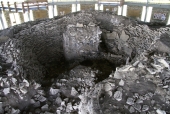Homepage > Learning Science through Nature > Geographical Areas
GEOGRAPHICAL AREAS

PICTURES
VIDEO
|
Cucuteni village and surroundings The video shows the Cucuteni village and surroundings, located nearby the railway station in Targu Frumos in the hillside region of Moldavia. Video presents also the Gosan hill, which used to be called “the Hill of the Kings”, visitors are welcomed by a range of wood sculptures, “vestiges” of annual craft work camps, symbol of an imaginary dialogue between pas-present, present-past. And on Gosan hill we can find the Museum of history and archeology Cucuteni. |
|
Cucuteni Tomb The video shows the defence brickwork of a Getic-Dacian princely tomb dating back to the IV century BC. The Getic-Dacian necropolis – 3.3 meters high and 35 meters in diameter – is a round stone enclosure with a south-east entrance. Inside the necropolis four tombs were found: a main one – for which the tumulus was raised – and three secondary tombs. |
|
Archaeological discoveries in the Cucuteni Tomb The video shows the archaeological discoveries of the main Cucuteni Tomb: ritually broken pottery, leaf shaped pendentives made of gilded pottery, beads, and adornments for women. |